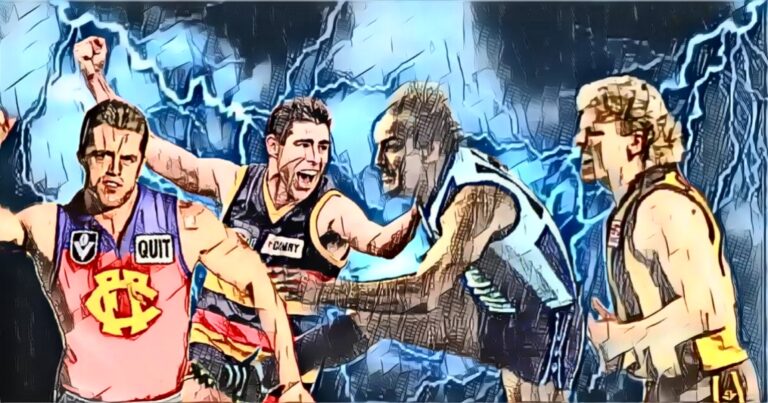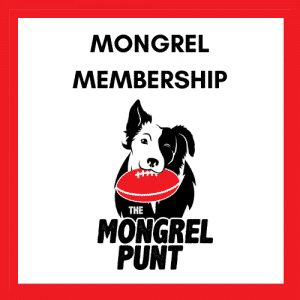Some players stand out in our memories and many of us, myself included, have lionised them over the years, making them seem grander than perhaps they really were.
The AFL Hall of Fame is littered with players who excelled at the highest level and achieved enormous feats of brilliance on the field, but not all players we’ll cover here will have been announced as part of the game’s elite.
Here at The Mongrel Punt, we have always endeavoured to look a little beyond the obvious, flitter between household names and some that maybe… just maybe have slipped your mind over the years.
In this series profiling the heroes of the game, we look at some of the players who were vital to their teams’ success in different capacities.
And believe me – there are plenty of them. And we ask – just how good were they?
You can find the previous three instalments of this series HERE.
MICK CONLAN – FITZROY
There are players on opposition teams that draw your eye. Usually, they are big forwards and the way they fly at the footy – it is hard not to feel the excitement when one of the big boys crashes into a pack and clunks a mark.
Then there is the small forwards who dance around and use sublime skill and fancy footwork to bamboozle a defender before slotting a goal.
And then there is Mick Conlan.
In a time when the great Leigh Matthews was in the twilight of his career, the Lions had this wrecking ball of a rover/small forward smashing through tackles and kicking snags like Lethal had been reincarnated.
Whilst the comparison is a little much – no one genuinely comes close to Matthews in terms of what he did on the field – Conlan was one of the players that made things happen. He was a ball of muscle, and would wade through attempted tackles, brushing them off like annoying insects as he rampaged toward goals.
Not many small forwards kick ten in a game, but Conlan did it in 1984, as the Lions mauled the Dogs. With him, you just got the feeling that at any point of the game, he was going to break out and have an influence – he was one of the players you always had to watch, whether you followed the Roys or not.
Oh, he was also the first bloke to be suspended via trial-by-video. Almost took Andrew Lockyer’s head off, but if you ask him, he’ll tell you there was not much in it – haha
TONY LIBERATORE – WESTERN BULLDOGS
There are not too many players you could bring up and say they changed the way the game was played, and have that opinion remain unchallenged.
I’m throwing this one out there – Libba changed the game.
He was the bridge between a game that was free-flowing, open, and offensive-minded, and took the art of tackling to a new level.
Of course, modern players tackle more, defensive structures and the rules allow for multiple stoppages, which lead to tight, in-close footy, but back in the nineties, it was Libba leading the way.
Here’s a nice set of numbers for you.
Lenny Hayes averaged 10% of the 2010 St Kilda team’s tackles. The Saints averaged 70.19 tackles per game when they went perilously close to the flag. Hayes had 7.08 per game top lead them.
Jude Bolton was a monster in Sydney, relishing the chance to drag an opponent down whenever the opportunity arose. He averaged 7.05 tackles per game in 2009. That’s 10.53% of the Swans’ tackle totals.
Matt Priddis averaged 8.55 tackles per game in his 2016 campaign, which is 11.69% of West Coast’s tackle totals for the season. With 188 of 1067, Priddis was a star.
And the all-time single-season leader, Scott Selwood had 8.08 tackles per game in 2011. The Eagles averaged 71 tackles per game. That’s 11.38% of his team’s tackles.
And now we get to Libba. Buckle up, babies.
Libba’s best tackling season was 1994. He amassed 142 tackles – a pittance by modern standards, right? How about if I tell you that the entire Footscray team had 625 tackles in total? Got your calculators out?
In 1994, before tackling was in vogue, Tony Liberatore averaged an incredible 22.73% of his team’s tackles. In a time people laud as being the best footy they can remember, little Libba was in the process of demonstrating the value of tackling when everyone else was trying to pick up a cheap kick.
He changed the game.
MALCOLM BLIGHT – NORTH MELBOURNE/WOODVILLE
Is there an argument that Malcolm Blight is the greatest player of all time?
He’s certainly in the discussion.
Despite smoking like a chimney, Blight did just about everything you could do in the game – won a Brownlow, won a Coleman in his final season in the VFL, won two flags as a player and two more as a coach, and managed to pull Gary Ablett Senior into line.
And that is just what he did in Victoria.
He won a Margarey Medal for Woodville before he headed to the VFL, and when he decided he’d had enough of the VFL, and returned to his beloved Woodville, he went out on a high note, snagging 126 goals in his final season of playing.
He then led Woodville, as coach, to the Preliminary Final after years in the wilderness.
Getting over the hump as a premiership coach took time – he also fell short with this Cats back in the now-AFL, finishing runner-up in 1989, 1992, and 1994 before he switched to coach the Crows and led them to back-to-back flags in 1997-98.
Anyone who watched Blight play was treated to something special. Sometimes, he would do the amazing – high marks, incredible running goals, and a torpedo goal after the siren that is revered as one of the greatest clutch goals in the history of the game, but he also brought a comedic element, as well. Taking his kick at goal again after kicking a point and levelling the scores, only to spray it out on the full and lose the game… or the time he ran into the open goal, got disoriented, and kicked a point… there was never a dull moment with Blighty.
And even if you thought there was… he probably couldn’t give a rat’s tossbag, right?
Oh, he also kicked my footy over two houses when I was a kid. It got lost… so he grabbed a couple from North Melbourne, including a signed one that I proceeded to ruin by taking it to school and playing with it on the gravel.
DERMOTT BRERETON – HAWTHORN/SYDNEY/COLLINGWOOD
I laughed during the 2024 season, when Michael Tuck was asked how Alan Jeans would have handled Jack Ginnivan at Hawthorn.
Tuck’s response?
“Jeansy had Dermott.”
Brereton is a lovable rogue, perhaps my favourite player ever to watch, with a mix of skill, power, and an air of violence just bubbling under the surface… and often flowing over the top of the rim!
Derm is one of the last players I can remember who could change a game without touching the footy. He had his own gravitational pull, be it for the footy, or for attention from the opposition, and didn’t he love it!
Never one to shy away from the spotlight, Derm tells a story of being singled out by Alan Jeans before the 1989 Grand Final. The context of Jeans’ challenge to Dermott was uncomfortable, and has never sat well with him as it related to family, but when he was felled in the opening seconds of the game, by Mark Yeates, Brereton proved what he was made of. It takes a certain type of person to dish it out, but the one who does that, then cops it when it is his turn… that’s a player I respect.
In a timeless moment, Derm was helped to his feet as he gasped for breath, refused to go off the ground, and staggered into the forward line where he took a mark and kicked a goal to ignite the Hawks.
If you could use a couple of minutes in any game to encapsulate a player, that two minutes does it for Brereton.
He was cooked after the 1992 season, and went from the Hawks to the Swans, but it was his final year at Collingwood that proved his value once more, as he played the role of protector to a young Saverio Rocca and snagged 30 goals.
DARREN JARMAN – HAWTHORN/ADELAIDE
I have never seen a player as balanced as skilled as Darren Jarman. Before or after him, I am not sure anyone has come close.
This bloke was a maestro with the ball in hand, and whilst there have been plenty who have sold candy, Jarman was like the Willy Wonka of football. He’d just hold the footy out there, his opponent would bite, and he’d drag it back in and dance around them like they were children.
His laser-like passing made life easier for Jason Dunstall, who had the pleasure of leading to Jarman, and after a pretty ordinary personal performance in the 1991 flag, Jarman redeemed himself with some huge finals performances in his role at Adelaide.
There was his Bulldog-killing final quarter in 1997, where he went forward to snag three goals and break the hearts of Dogs supporters, and he followed that up with 11 goals across two Grand Finals in 97 and 98.
Jars always looked a little untidy when he played, as though he was one of those players that cruised by on talent alone for a while, because the talent level was so damn much higher than just about everyone else, but once he trimmed down and did the work, he became such a phenomenal weapon at the highest level.
If you’ve seen a better-skilled player than Jars, let me know. The man was a magician with the footy – an absolute joy to watch.
As always, massive thanks to those who support this work. It is a labour of love for me, and having you guys as members of the site basically keeps me going. So sincerely… thank you – HB
Like this content? You could buy me a coffee – I do like coffee, but there is no guarantee I won’t use it to buy a doughnut… I like them more. And I am not brought to you by Sportsbet or Ladbrokes… or Bet365, or any of them.



